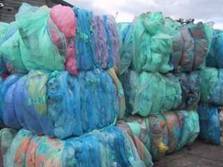Types of Scrap Plastic
Whilst most people who visit our site will be familiar with the common type of plastics, there are actually around 50 different types. Each of these types will have variants with different properties and uses.
The most common plastic types have been designated with numbers from 1 to 6. However, each of these may have dozens of different molecular weights, tensile strengths, and hardness. These can be further modified by adding other chemicals, such as plasticizers and fillers, which will further change the properties and uses.
These variations can be very significant in deciding the desirability and value of the plastics for recycling. Ultimately, it comes down to the simple economics of supply and demand. Whilst some virgin polymers can be incredibly expensive to purchase, the value of the waste for recycling can be much lower than that of a very common plastic. A plastic can be too specialized with no demand for the recycled material.
Some plastic types are laminated or co-extruded to give the benefits of different polymer types within one piece of plastic. This is very common within the food packaging industry. The value of these can be very low and many are not recyclable.
At Lovewaste we have the expertise to identify your plastic scrap and the experience to quickly match an end user and value to the material. If you are not sure about the potential value or cost of waste plastics then talk to us, we will give an honest appraisal and ensure that, whether you are buying or selling, that you achieve the correct price.
PET
The most common use for recycled PET is to make staple fibre. It is also used to make non-woven fibre, sheet, film, containers. Forms of PET waste include PET Trays or skeletal waste, PET bottle flake, PET bottle fine, PET bottle performs, PET purge, PET floor sweeping pellets, PET prime and off-grade pellets, PET fibre waste.
The most common use for recycled PET is to make staple fibre. It is also used to make non-woven fibre, sheet, film, containers. Forms of PET waste include PET Trays or skeletal waste, PET bottle flake, PET bottle fine, PET bottle performs, PET purge, PET floor sweeping pellets, PET prime and off-grade pellets, PET fibre waste.
PP
PP is commonly used in packaging applications. In film form it has excellent transparency and can be BOPP has good strength. It is also often used for rigid applications such as buckets, pots, and crates.
PP is commonly used in packaging applications. In film form it has excellent transparency and can be BOPP has good strength. It is also often used for rigid applications such as buckets, pots, and crates.
LDPE
Mostl commonly used for polythene film, (grades include Jazz, 50/50%, 90/10%, 95/5%, 98/2%, 99/1%, 100% natural film ), MRF baled films, agricultural film. It can be used for containers and pipes but this is less common.
Mostl commonly used for polythene film, (grades include Jazz, 50/50%, 90/10%, 95/5%, 98/2%, 99/1%, 100% natural film ), MRF baled films, agricultural film. It can be used for containers and pipes but this is less common.
PS
PS grades include GPPS, HIPS, EPS. Common used for trays, CD cases, coathangers, Fridge plastics, TV cases, EPS electical packaging and EPS fishboxes.
PS grades include GPPS, HIPS, EPS. Common used for trays, CD cases, coathangers, Fridge plastics, TV cases, EPS electical packaging and EPS fishboxes.
Engineering Plastics
Engineering plastics include ABS, PMMA, PC, SAN, POM, PA (6,66,11,12) PA+GF (10-40%) PVB, PBT, PPO, TPU, TPO, TPE, EPDM, EVA, PC/ABS, PC/PBT, CA, CP.
Engineering plastics include ABS, PMMA, PC, SAN, POM, PA (6,66,11,12) PA+GF (10-40%) PVB, PBT, PPO, TPU, TPO, TPE, EPDM, EVA, PC/ABS, PC/PBT, CA, CP.
PC
PC is used for large water bottles (the type used for water coolers), CD ,DVD, and some applications where clarity and strength are important (such as spectacle lenses)
PC is used for large water bottles (the type used for water coolers), CD ,DVD, and some applications where clarity and strength are important (such as spectacle lenses)
Others
There are a vast range of other plastics, including engineering plastics such PTFE, LCP, PPS, PSU, PES, PEI ( Ultem 1000-1010, 2300 ), PEEK, but also including mixed, lamianted, or co-extruded polymers such as PE/PA Film.
There are a vast range of other plastics, including engineering plastics such PTFE, LCP, PPS, PSU, PES, PEI ( Ultem 1000-1010, 2300 ), PEEK, but also including mixed, lamianted, or co-extruded polymers such as PE/PA Film.














